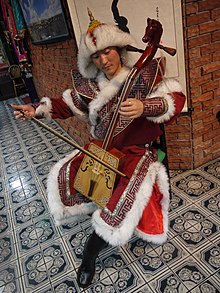 A Mongol musician playing an Inner Mongolian-style morin khuur | |
| Total population | |
|---|---|
| 6,290,204[1][2] | |
| Regions with significant populations | |
| |
| Languages | |
| Religion | |
| |
| Related ethnic groups | |
| Mongols in China | |||||||
|---|---|---|---|---|---|---|---|
| Simplified Chinese | 中国蒙古族 | ||||||
| Traditional Chinese | 中國蒙古族 | ||||||
| |||||||
Mongols in China,[3][4] also known as Mongolian Chinese,[5][6] are ethnic Mongols who live in China. They are one of the 56 ethnic groups recognized by the Chinese government.
As of 2020, there are 6,290,204 Mongols in China, a 0.45% increase from the 2010 national census.[1][2] Most of them live in Inner Mongolia, Northeast China, Xinjiang and Qinghai. The Mongol population in China is nearly twice as much as that of the sovereign state of Mongolia.

The Mongols in China are divided between autonomous regions and provinces as follows:
Besides the Inner Mongolia autonomous region, there are other Mongol autonomous administrative subdivisions in China.
Prefecture level:
County level:

China classifies different Mongolian groups like Buryats and Oirats into the same single category as Mongol along with Inner Mongols. A non-Mongolic ethnic group, the Tuvans are also classified as Mongols by China.[7] The official language used for all of these Mongols in China is a literary standard based on the Chahar dialect of Mongol.[8]
The ethnic classification might be inaccurate due to lack of information regarding the registering policy.[9][10]
Some populations officially classified as Mongols by the government of the People's Republic of China do not currently speak any form of Mongolic language. Such populations include the Sichuan Mongols (most of whom speak a form of Naic language), the Yunnan Mongols (most of whom speak a form of Loloish language), and the Mongols of Henan Mongol Autonomous County in Qinghai (most of whom speak Amdo Tibetan and/or Chinese).
Among the Mongols of China, mitochondrial haplogroup D was in first place (27.07%), followed by mitochondrial haplogroups B (11.60%), F (10.77%), Z (8.01%), G (7, 73%), C (6.91%), A (6.08%), N (5.25%) and M7 (5.25%). Other mitochondrial haplogroups (HV, H, I, M8, M9, M10, M11, R, T, U, W and Y) were sporadically distributed among the studied Mongols of China with frequencies of no more than 1.66%.
Guang-Lin He et al. (2022) examined a sample of current Mongols of China (n=175, including n=97 from Inner Mongolia, n=27 from Liaoning, n=10 from Heilongjiang, n=10 from Jilin, n=3 from Qinghai, n=3 from Xinjiang, and n=25 from elsewhere in China) and found different haplogroup O subclades (107/175 = 61.1% in total) to be the most frequently observed Y-DNA haplogroup:
The second most frequently observed Y-DNA haplogroup among the sampled Mongols from China was C2 (22.9%, including 16.6% "Northern" i.e. Mongolian/Siberian C2b1a, 1.7% typically Mongolic C2c1a1a1-M407, and 4.6% "Southern" i.e. East Asian C2c1(xC2c1a1a1)), followed by N1-CTS3750 (6.3%, including 2.9% N1a2a1a~, 1.1% N1a2b2a1c~, 1.1% N1b2a2~, 0.6% N1a1a1a1a3a, and 0.6% N1b1), Q (4.6%, including 4.0% Q1a1a1 and 0.6% Q2a1a1), R1a1a1b2a-Z94 (2.3%), and D-M533 (1.1%). Y-chromosomal haplogroup E1b1b1a1b2 (V22) was observed in one Mongol individual from Hohhot, G2a2b2a1a1a2a1a (L654.2) was observed in one Mongol individual from Alxa League, and I2a1b2a1a1a1 (BY128/Y5596) was observed in one Mongol individual from Hinggan League.[11]
Not all groups of people related to the medieval Mongols are officially classified as Mongols under the current system. Other official ethnic groups in China which speak Mongolic languages include:
Mongols living in China face a multitude of Anti-Mongolian discriminations by the current Chinese government on the goal of assimilating the Mongolian population into the Han population.[12][13][14] Some instances of discrimination include: barring teaching the Mongolian language in schools, arresting Mongols on Mongolian soil, and forced evictions of Mongolians in China.[15]
Recently the NPC mandated that "minority language-medium education is unconstitutional (People's Daily)," enforcing this within Inner Mongolian schools, banning the teaching of the Mongolian language, along with riding of different kinds of Mongolian material that are deemed to de-emphasize Chinese nationality and common identity.[16][13] In 2023, a book on the history of the Mongols was banned for "historical nihilism."[17]
Most recently on May 3, 2023, the Chinese government arrested Mr. Lhamjab Borjigin, a Mongolian writer, in Ulaanbaatar, Mongolia.[15] This isn't the first time China has made these kinds of arrests on foreign soil against Mongols either, as this is the fifth occurrence.[15]

The Chinese government has even gone as far as accusing Mongolian herders/nomads of causing climate change in order to justify the forced relocation of Mongolians out of their ancestral land.[14] Under the "ecological migration" policy, the Chinese government has moved thousands of Mongolians into city/urban areas away from their home grasslands on the basis that the Mongolian nomadic lifestyle is destroying the grasslands and causing climate change symptoms like desertification and sandstorms.[14] The Chinese government also justifies the movement of Mongols, calling it poverty relief, as hundreds of thousands of Mongols live in extreme poverty, however many of the displaced Mongols actually fall deeper into poverty, while also feeling out of their element and feeling like outcasts in their new homes.[14] The basis of moving the Mongols by the claim of climate/environment protection is one that lacks support, as it has been found that nomadic lifestyles, like that of the grassland Mongols, actually harm the environment far less than permanent settlement lifestyles.[18]